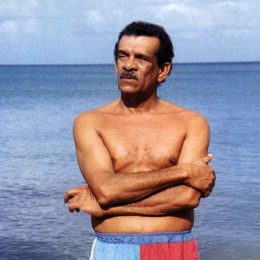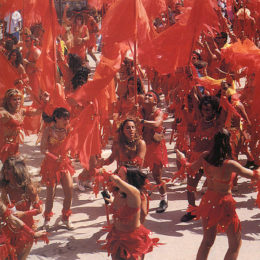There are more than 30 jazz festivals every year in the Caribbean and most Caribbean people have never been to one. Wynton Marsalis, Dizzy Gillespie, Kenny G, Joe Sample, Andy Narrell, and a host of others who could turn heads in international airports, come and go largely unnoticed. And there is a good reason for this: most people in the Caribbean don’t really need jazz – they’ve got perfectly good music of their own, thank you.
From Jamaica in the north to Trinidad in the south, most of the islands of the West Indies have produced indigenous musical forms which their people care about passionately, usually to the exclusion of all others. For many years before Jamaica gave the world Bob Marley and reggae, the population of Kingston grooved to ska, reggae’s immediate predecessor, without a care or thought for anyone else’s music. Jamaicans would listen to foreign pop songs only if they were presented in a reggae format by a local singer. In the Caribbean islands with strong French influences, cadence is king and zouk is Prince Regent.
Most of the Eastern Caribbean is hooked on soca, the modern, bass-driven dance music which evolved out of Trinidad and Tobago’s traditional calypso, onto which the other islands have grafted their own styles, ranging from the brass-punctuated, soaring vocal style of Barbados’s Mighty Cabby to the swaying, harmony-rich sound of Antigua’s Burning Flames.
The islands are fiercely proud of their own musical forms, almost to the point of obsession, so that even the music of other islands is often regarded with suspicion. Even when the music of another island is accepted, locals feel compelled to claim the music was originally theirs, as happened when Barbados adopted Trinidad’s calypso. Only in very recent times have the intra-Caribbean musical barriers begun to come down.
So the presence of jazz in the Caribbean at all is something of a mystery. Thirty jazz festivals a year featuring artists of the standing of Dizzy Gillespie and Wynton Marsalis require a explanation: if people like Paxton Baker, the young American who organises the jazz festivals in Aruba and St Lucia (for the St Lucia Tourist Board) last year, are responding to a market stimulus, just who is listening to all that jazz in the Caribbean?
The short answer is that much of the audience at jazz festivals in the Caribbean is foreign. The Caribbean jazz festival is organized to draw its own market.
But a distinction must be made. There are Caribbean-jazz festivals, like the October Jazz Festival in St Lucia (the second event for the year) or the Pan Jazz Festival in Trinidad. These involve Caribbean musicians and Caribbean music. And then there are jazz festivals in the Caribbean, which are considerably more numerous. They can be found all over the region, from Bermuda to Aruba; they do not necessarily feature any Caribbean jazz musician, and they are attended by people who fly in for the purpose.
Most of the live jazz heard in the Caribbean is played by visiting musicians for visiting audiences. St Lucia’s inaugural jazz festival last year (1992) was designed partially as a tourist promotion and was meant to work hand-in-hand with the island’s well-established Aqua Action festival which took place the following weekend. And it worked: there were more visitors, even from other Caribbean islands, than there were St Lucians at the Cultural Centre in Castries to hear Joe Sample and Bobby Watson play.
Having said that, however, there is usually at least a small local crowd at jazz events, and Caribbean-jazz festivals are feverishly supported by indigenous music lovers, some of whom, admittedly, might go for the “pan” in the pan jazz. In every territory of the Caribbean, there are local jazz devotees who spend disproportionate amounts of time and money pursuing jazz.
Some names keep cropping up, family-style, almost incestuously. Barbados’s Scofield Pilgrim, the manager of the young Bajan sax wizard Arturo Tappin, lived for many years in Port of Spain, Trinidad, and introduced many Trinidadians to jazz. Trinidad’s own Gene Lawrence is the secretary of the jazz society in St Lucia, where he has been living since the 1980s. It is men like these who introduced jazz to the Caribbean in the first place.
Jazz, like calypso, reggae and samba, emerged out of and is rooted in the phenomenon of African slavery in the New World. It evolved directly out of the blues, the rawest musical form beyond screaming, in which the dispossessed African gave voice to his position. If the blues unlocked the door of captivity, jazz held it open while the prisoner looked out. Jazz was the blues with a bit of polish. It was the music through which the disadvantaged and oppressed black American sought to interpret his world.
But one of the quirks of jazz in the Caribbean is that, at grassroots level, it is a much smaller business than any of the mainstream Caribbean musical forms. Arturo Tappin, the father and namesake Arturo Tappin the Barbadian saxophonist (with typical Bajan common sense, the elder Tappin is called “Art” and the younger one “Turo”), was first exposed to the Jazz music his son was weaned on when he left Barbados and went to university in North America. Not many people in Barbados go to school in the United States today, and thirty years ago even fewer.
Jazz was the pop music of the day, and when Art Tappin returned to Barbados he brought it with him the way today’s Caribbean youth going to colleges in Miami might bring home the new Guns ‘n’ Roses album or a Naughty by nature T-shirt. A substantial part of the Caribbean jazz audience is made up of people like Art Tappin, professionals who went to University in Europe and North America when Jazz was pre-eminent.
The nature of the audience has had a strong influence on the way jazz events are promoted in the region. The local audience can’t find fund thirty-plus festivals a year. There are few shows featuring one artist, partly because of the small size of the populations and therefore the market, but mainly because the Caribbean jazz fan, and indeed the jazz fan who comes to the Caribbean, is more willing to spend more money on a bigger show than a lesser amount on a smaller show. The bigger the event, the more likely there will be a crowd, and the bigger the crowd will be. Jazz in the Caribbean is the marketing man’s dream.Jazz music is curiously well-suited to the people of the Caribbean. It is in keeping with their history and their nature. Jazz speaks, not of Africa or Europe, but of a place between the two, the New World. The music of Europe, classical music, is listened to with the mind. The music of Africa, the drum, is an extension of the heartbeat and is listened to with the heart. Jazz springs from the heart into the mind and is listened to with both: it is whole music. It is the perfect music to express the fusion of different approaches – which is precisely what the Caribbean is all about.Other aspects of jazz seem entirely Caribbean. Where European classical music stresses the importance of discipline and playing what the composer wrote down, jazz underlines the freedom of the individual to play what he makes up. Thelonius Monk said there are no wrong notes; Miles Davis said if you play a wrong note, it’s the note that follows it that makes it right or wrong. This, surely, is the music for a region where everyone you meet is a “character” and the only thing limiting personal freedom is the unanimous disapproval of everyone else.
Again, the major distinguishing characteristic of jazz is the ability of its exponent to improvise. In the two major musical forms in the English-speaking Caribbean, calypso and reggae, the ability to create on the spur of the moment, to improvise, is equally important, whether it be called “extempo” or “chanting”. There is also a strong element of “showing off’ in jazz music, even if it is approached with humility.
The natural affiliation between the region and jazz is mirrored by the growing influence of jazz on local musicians – arrangements at the Panorama steelband competition during Trinidad’s Carnival have become increasingly “jazzy” over the years, and the local love for jazz-influenced pan music is the basis for the always-sold-out Pan Jazz and Pan Ramajay festivals in Trinidad.
But even though the music fits the Caribbean so well, regional appreciation of mainstream jazz may not survive the first wave of its adherents, the Art Tappins of the region. “I didn’t know I was playing jazz,” Turo Tappin says. “I was in the cadet band at school and I was just playing what I was feeling and they told me not to play that, to play what was written down on the music sheet … but I had to play what was inside. When I found out it was jazz, I joined a jazz band. ”
There are moves afoot to publish Caribbean jazz pieces and produce a Caribbean Jazz Directory. The Caribbean’s jazz players are full of enthusiasm and commitment. But if there is hope for mainstream jazz, it lies with festivals of Caribbean jazz (as distinct from jazz festivals in the Caribbean) and with younger jazz musicians like Barbados’s Arturo Tappin. There may not be many Caribbean jazz bands around by the time the third Arturo Tappin picks up his sax.






















